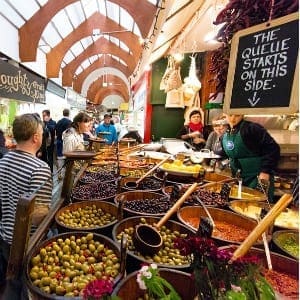 The trends were observed by BENCHMARK®’s executive chefs and culinary experts at the company’s 80 luxury hotels, resorts and restaurants coast to coast, offshore and in Europe.
The trends were observed by BENCHMARK®’s executive chefs and culinary experts at the company’s 80 luxury hotels, resorts and restaurants coast to coast, offshore and in Europe.
“Food and Beverage is an ever-evolving realm of experiences”, says Patrick Berwald, Benchmark’s vice president food and beverage. “The opportunity for us is not only to be ahead of the trend but to understand who tomorrow’s customer will be, what fulfills their needs and how our properties can be ready to meet that demand”.
2019 dining trend #1
The tea party.
While three cups of tea are consumed worldwide for every cup of coffee, here in the U.S. coffee drinkers are dramatically becoming cuppa fans. This is not a new trend, but what is new is how people are beginning to think of tea with the same reverence as coffee due to its many varieties, applications and benefits. One’s local coffee roaster may soon have a new neighbour in the form of a “tea bar”. Craft tea blending, nitro tea on tap and even tea cocktails will start to proliferate on Main Street.
2019 dining trend #2
Meat lovers.
Not yet available to buy commercially, heme (from the Greek word for ‘blood’) is at the cutting edge of food science and is a possible stepping stone to a more environmentally sustainable meat and protein alternative. Tech-food companies are using it to bring a meaty quality to their wheat and potato protein burger with the “bloodiness” of meat cooked rare. Not to worry, if you still enjoy good old-fashioned beef – select steak restaurants will be expanding their repertoire to include new cuts like Vegas Strip steak (from the shoulder area), merlot cut (from the heel) and bavette (the bottom part of sirloin known as flap meat).
2019 dining trend #3
Fermented.
Big brand kombucha (fermented tea) has cemented itself in the new age of alternative beverages, but consumers will soon see various styles of home-grown kombucha coming out of boutique/lifestyle hotels and chef-driven, trendy eateries. Further to the fermented craze, these same businesses will expand their line to include more kimchi, pickles, sauerkraut, tempeh, kefir, but also carrots and cream; and many other foods fermented, cooked and offered to customers. All with the focus on consuming the least processed food possible – increasing probiotics to improve the immune system.
2019 dining trend #4
Tastes like crickets!
As food costs continue to rise, chefs are looking for new sources of protein. Insects appear more and more as a sensible choice on many levels. They exist in large quantities and can be found everywhere. In fact, 80 per cent of the world consumes insects: low in fat and 3-4 times as much protein as beef, insect powders can enhance your cocktails and even cricket flour can be used to make bread and pastries. Their products will soon flood the shelves of grocery stores and restaurants alike.
2019 dining trend #5
Farm to table 2.0.
One trend that has been in the works for some time now, of course, is the farm to table movement. It has recently taken a brand-new path and that is the chef/farmer movement of custom farming in regard to specifying what seeds are being planted for new menu development. Benchmark’s Willows Lodge has partnered with a farm in their valley, which is helping to cultivate a new type of a relationship that will change the way each supports the other to sustain farming inside their community, ultimately, saving the small, sustainable farms for generations to come.
2019 dining trend #6
Are you in or out?
In an age of online and mobile food-ordering services, diners have moved away from eateries to placing more value on being home-bound and the convenience of delivery. However, we project that diners will stop unwrapping their plastic packages of cutlery and again recognise that restaurant dining offers more compelling and satisfying experiences, which truly nurtures the soul. Whether it is celebrity spotting, educating your taste buds on adventurous cuisine or building relationships in social atmospheres – outside eateries offer all things you just can’t get at home.
2019 dining trend #7
The vegetarian factor.
What was once seen as the random individual that a restaurant chef or an event manager had to appease, now has become more than a minority in the way chef’s approach menu offerings. With today’s diners increasingly aware of their “macro diets” combined with culinarians applying unique and creative takes on mom’s succotash, menus will soon see a large portion dedicated to vegetarians and what is plant-based and coming from the ground. Dishes are even becoming vegetable-focused, with proteins as the complement. Even vegetarian tasting menus are quickly becoming the staple in many accredited establishments.
2019 dining trend #8
Food & the greater good.
The Food & Beverage and hospitality industries are no strangers to supporting the hungry and less fortunate: from children to shut-ins. However, with a global focus on the natural disasters humanity faces – the collective culinary community is starting to put their food where their mouth is and put greater efforts behind charities that provide sustainable support. Chefs are beginning to make more meaningful connections around food: less about social media and more about that they take on the deeper issues and how food is involved.
2019 dining trend #9
No substitutions, please.
Chefs are ready for a remix of the typical ingredients diners have become all too familiar with. Citrus is a widely used component in many dishes and libations, but soon we will see regular cameos by unique and eclectic relatives to the lime and lemon – citron, cumquat and shaddock. Kale has outlived its welcome and will soon be replaced by such wild weeds as sorrel, dandelion greens and amaranth. Finally, put away the honey and agave as life will become a bit sweeter with derivatives from sources like carrot, sweet potato, golden beet, butternut squash and corn.
2019 dining trend #10
Dietitian, the new celebrity chef.
Culinarians speak about healthy eating, but this is far from nutrition, which is much more rooted in the science of food. Professional dietitians will rank alongside celebrity chefs – as the benefits of understanding nutrition combined with leveraging technology will allow consumers to personalise their food experiences. Consumers will begin to craft personal portion sizing relative to their dietary and nutritional needs. The convergence of mobile and Internet technologies will allow providers and core consumers to have access to personal dietary requirements at restaurants, retail locations and quick-service eateries. Personally-assigned nutrition will become commonplace and a major influence on diet.



















